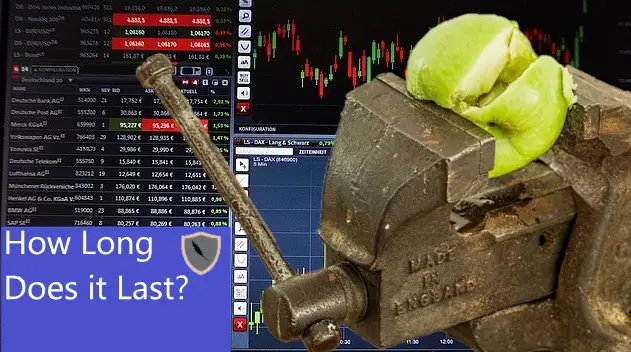A stock portfolio simply explained is just a collection of stocks that are ‘housed’ in a portfolio. In reality a portfolio can be thought of as a house, if you design a good house and use the right materials it will stand the test of time.
The 5 steps to build a successful stock portfolio are; First, find your investment timeline and goals. Second, find your investment methodology. Third, Build the foundation of the portfolio with solid assets. Fourth, add in high growth assets to beat normal market return. Fifth, add a hedge to your portfolio to hedge against losses.
If none of that makes sense don’t worry, I am going to show you how to engage with each one of the above steps to reduce your risk and create massive economic upside.
As always if you like content like this then you should share on social media and subscribe to the newsletter!
Alright, enough hot-air. Let’s jump right into how to build a successful portfolio.
First, Your Investment Timeline and Goals
This is where we need to be realistic with ourselves. We need to ask ourselves “how much money do I want to have by ‘x’ date in the future.”
By knowing our investment timeline we can decide how much risk we want to have in our portfolio. For example, If you say you only want to return 12% per year over the next 50 years then we won’t have to build a very risky portfolio because you have the time to grow the wealth conservatively over time.
So what happens if you want to go for gold and get 25%+ year over year? Well then we are going to introduce significant risk into the portfolio. This isn’t by itself a problem if it’s done properly, I will show this later on.
What’s important is that right now we can define your investment timeline. You need to figure out how many years you want your ‘capital’ or investment to be tied up in investments. The longer you have the less risk you need to take on.
Risk to Goal Percentage Gain
The above image illustrates how much risk you need to take on in a portfolio as you pursue a higher goal percentage. As you increase your return rate eventually your risk will overtake your ‘reward’ percentage.
The way to combat this increasing risk profile is to use the next step. Finding a good investment methodology.
Second, Your Investment Methodology
Every single investment portfolio on the planet has an investment methodology. Most of the time it is just the investor thinking that these stocks will increase over time.
If you think that a stock’s value will increase over time then that is the methodology of going long on stocks. You buy shares with the idea that they will increase in price over time. As such you are holding the stocks for a ‘long’ time, which makes your investment methodology long only.
There are several other investment methodologies. Each one introduces a different ‘style’ of how you invest in the market. Below are a couple of the most popular and readily investment methodologies available to normal investors.
- Long Only
- Long/Short
- Quant Trading (Algorithm)
- Market Neutral
There are several others such as activist but they are not available to us normal people. You would have to have a ton of money in order to engage in either activist or private equity.
Here is a very simple explanation of the above list of methodologies.
Long Only
For this investment methodology you are only buying shares with the idea of selling them at a later date when the price of the stock rises above your ‘entry’ price.
This is by far the most common investment methodology. You just buy shares and sell them at a later date.
That’s all there is to it.
Long/Short
Here is when you both go ‘long’ and ‘short’ on stocks. We already touched on going long, or buying and holding shares. Let me explain ‘short.’
Going short on a stock means shorting or betting the stock will go down. It allows you to make money in the market even when a stock fails. For example in 2005-2008 everyone was shorting the rental-video industry as online streaming platforms started to take off.
By shorting investors were betting that a stock was going to fall in price and they would make money. For a full rundown on how shorting works check out this article that goes into detail on how it works and how to do it.
Shorting a Stock Explained: Making Money When the Stock Goes Down.
With the long/short methodology you are investing in stocks that are both going to increase in value over time and stocks that are going to fall in price over time. This allows you to double your investment opportunities in the market and potentially make more money.
Quant Trading
Ok, here is where things get tricky.
Quant Trading is an investment methodology where you employ the aid of a computer algorithm to auto-trade several thousand times per second. The goal here is to exploit the minute difference between price discrepancies in the market.
This is also called an arbitrage trade strategy. Which means that it really only focuses on short timelines and price discrepancies between assets/stocks. Below is a post on how to ‘play the spread.’ It outlines the overall process it takes to exploit buyers and sellers in the market.
What is the Spread on a Stock: Simple explanation with pictures
I wouldn’t engage in this type of investing methodology unless you know what you’re doing. This is because a runaway program can lead to something called a ‘flash-crash.’ This would wreck your portfolio.
That being said, if you know what you’re doing and you’re comfortable with Python and the Pandas library then go for it.
Market Neutral
This is one of my favorites. The market neutral methodology allows you to make money regardless of what is happening in the market.
Here you are sacrificing large gains to make a consistent and predictable return in the market. To do this you need to use creative trading strategies such as Iron Condors, futures, or bond ‘sprinkling.’
The goal here is to buy a collection of assets that will generate a return over time regardless of the direction the market takes. A good way to break into this is to study how pairs trading works. Here is an article on that.
Pairs Trading Stocks: Everything You Need To Know To Start Making Money
Third, Build the Foundation of the Portfolio with Stable Assets
Just like with building a house or a bridge you need to have a solid foundation before you can begin.
Investment portfolios are no different.
You absolutely need to have a solid foundation of stable assets. The best way to go about this is to buy stocks/assets that have performed very well over time and are expected to continue to do so.
These can be treasury bonds or large index fund ETFs such as the SPY.
20 year chart on the SPY
Typically for my portfolios I will first find the investment methodology and then find the most stable asset that fits for the portfolio.
For example if I am going long or long/short then I will invest in the SPY because I know that I will get between 8-12% return year over year with little excess risk.
This is because the SPY invests in the top 500 companies by market cap in the United States. Companies such as AAPL, GOOGL, and MSFT. These companies are going to do well in the next 5,10,15 years so it’s a stable investment.
This forms the foundation for the portfolio. The next step is when we start having fun.
Fourth, Add in your High Growth Assets that Beat Market Return
Now is when we can go out searching for the investment opportunities that will generate good market returns.
For long/short or long methodologies you should find mid-cap stocks that are innovating and returning growing revenue streams. Take whatever allocation you want to dedicate to this and sprinkle it out across 20-30 of these stocks.
Some good picks for this currently are as follows.
- EXPO
- ASPN
- STAG
- NEE
- LAND
You can either do the research on your own or just simply tune in to this website, ChronoHistoria.com, to figure out what stocks are being researched.
By throwing in these high growth stocks you are exposing yourself to gain significantly in your portfolio. This is why this part is the most fun.
You are going after the stocks that will return the highest return for your investment methodology. If I was selling Iron Condors as an investment methodology I would look for high IV spreads that are undergoing consolidation.
For long/short I simply look for failing companies to short and growing companies to go long in.
Like any other skill it takes practice but dedicate about an hour a day to learning investing and before you know it you will be returning 14%+ year over year with little risk.
Money Man knows what’s going on.
If you want to bump those numbers up and take on more risk you can get in the range of 50%+! Be warned however, the higher the return goal the higher the risk. That’s unavoidable.
Fifth, Adding a Hedge to your Portfolio
Ok, so nobody is perfect. I have made every mistake in the book when it comes to investing. Chances are you will as you continue on this journey.
This is why we add a ‘hedge’ to our portfolio. Essentially we are betting against ourselves by investing in assets that will gain in value as our primary assets decline in value.
A hedge should be no more than 5% of your portfolio.
A classic hedge is to buy gold to hedge against the value of the U.S market. If you’re invested heavily in the U.S market(SPY) and it plummets in value then the price of Gold will rise.
See the below image for proof of this! (Look at 2008/2020 on GLD and 2008/2020 on SPY)


To find the hedge for your portfolio find what would increase in value as your stocks/assets decline. Who would gain if those stocks lost.
It takes a bit of creativity but once you get it then just allocate 5% to that hedge. That way if you lose money your hedge will gain in value and in theory you will only lose a small percentage.
Conclusion
Understanding the 5 steps to build a successful stock portfolio will allow you to gain increasing returns that are well above market average (10%). Further, it will allow you to become more ‘flexible’ with how you invest and allow you to exploit emerging trends in the market.
This is why practicing investing and portfolio building is so important to building long term wealth easily. Simply spending an hour a day learning how to invest can net you huge returns in the long term and as a result is one of the best things you can do for your long term financial well being.
As always if you like content like this then you should share on social media and subscribe to the newsletter. Every share helps me help others so its greatly appreciated.
Further, check out some of our recent posts below.
-
How Long Does a Short Squeeze Last? (3 Answers)

What is the time frame for you short squeeze? Well here is everything you will ever need to know to determine how long it will last.
-
Why You Still Own a Stock After It’s Delisted and How to Sell It

Do you still own a stock after its delisted? How do you sell it? Don’t worry the stock is still worth money and here is how to sell.
-
Can You Make 1% A Day in the Stock Market? (3 Steps)

Making 1% a day in the stock market is hard but defiantly doable. Here are 3 simple steps to helping you achieve this return.
Until next time, I wish you the best of luck in your investments!
Sincerely,


